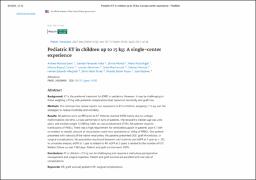Pediatric KT in children up to 15 kg: A single-center experience

View/
Date
2021-12Author
Exeni, Andrea.
Falke, German.
Montal, Silvina.
Et al.
Metadata
Show full item recordAbstract
Abstract
Background: KT is the preferred treatment for ESRD in pediatrics. However, it may be challenging in those weighing ≤15 kg with potential complications that impact on morbidity and graft loss.
Methods: This retrospective review reports our experience in KT in children, weighing ≤15 kg, and the strategies to reduce morbidity and mortality.
Results: All patients were on RRT prior to KT. Patients reached ESRD mainly due to urologic malformations (54.54%). LD was performed in 82% of patients. The recipient's median age was 2.83 years, and median weight 12.280 kg. Male sex was predominant (73%). All patients required transfusions of PRBCs. There was a high requirement for ventilated support in patients post-KT with no relation to weight, amount of resuscitation used intra-operatively or ml/kg of PRBCs. One patient presented with stenosis of the native renal artery. No patients presented DGF, graft thrombosis, or surgical complications. No association was found between cold ischemia and eGFR at 1 year (p = .12). In univariate analysis, eGFR at 1 year is related to AR. eGFR at 3 years is related to the number of UTI. Median follow-up was 1363 days. Patient and graft survival were 100%.
Conclusions: KT in children ≤15 kg can be challenging and requires a meticulous perioperative management and surgical expertise. Patient and graft survival are excellent with low rate of complications.
Keywords: AR; graft survival; pediatric KT; surgical complications.
© 2021 Wiley Periodicals LLC.
Collections
The following license files are associated with this item:

